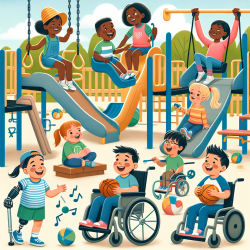In today's world, inclusive playgrounds are essential to ensure that all children, regardless of their abilities, have access to play and its numerous benefits. The recent scoping review titled A Scoping Review of Evidence-Informed Recommendations for Designing Inclusive Playgrounds offers valuable insights that can help practitioners enhance their playground designs to be more inclusive.
Here are the key takeaways from the review and how you can implement them:
1. Entry Points
- Wide and Obstacle-Free Entrances: Ensure playground entrances are wide enough to accommodate mobility devices and free of obstacles.
- Wide, Flat, and Firm Pathways: Create pathways that are wheelchair accessible and wide enough for two wheelchairs to move side-by-side.
- Enclose the Playground: Consider enclosing the playground with fencing to prevent children from straying, especially those with autism spectrum disorder (ASD).
2. Surfacing and Paths
- Flat, Uniform Surface: Use a firm and stable material for the playground surface, such as poured-in-place rubber, to ensure accessibility and safety.
- Ramps for Elevated Play Components: Incorporate ramps that provide access to and between elevated play structures to accommodate children using mobility devices.
3. Features to Foster Inclusive Play
- Accessible Play Equipment: Include play equipment that can be used independently or with minimal assistance by children with disabilities.
- Variety of Play Equipment: Provide a diverse range of play components that offer appropriate challenges for children of all ages and abilities.
- Sensory-Based Play Components: Incorporate musical, tactile, and visual elements spread throughout the playground to engage children with sensory processing disorders.
- Solitary Play Components: Offer quiet, private spaces within the playground where children can escape overstimulation.
- Recognizable Designs: Use play components shaped in recognizable designs to foster creative and imaginative play.
- Informational Features: Provide features that aid with spatial orientation, communication, and guidance on equipment use, such as contrasting colors and braille descriptions.
- Shaded Spaces: Ensure the playground has shaded areas to help children who have difficulty regulating their body temperature.
4. Staffing/Supervision
Having trained staff present in the playground can support inclusive play by providing physical or instructional assistance and facilitating social interactions among children with and without disabilities.
5. Design Process
Involve families of children with disabilities and representatives from disability organizations in the design process to ensure the playground meets the unique needs and interests of children with disabilities.
Implementing these evidence-informed recommendations can significantly enhance the inclusiveness of playgrounds, ensuring that all children can enjoy the benefits of play. For a more detailed understanding and additional insights, practitioners are encouraged to read the original research paper.
To read the original research paper, please follow this link: A Scoping Review of Evidence-Informed Recommendations for Designing Inclusive Playgrounds.










